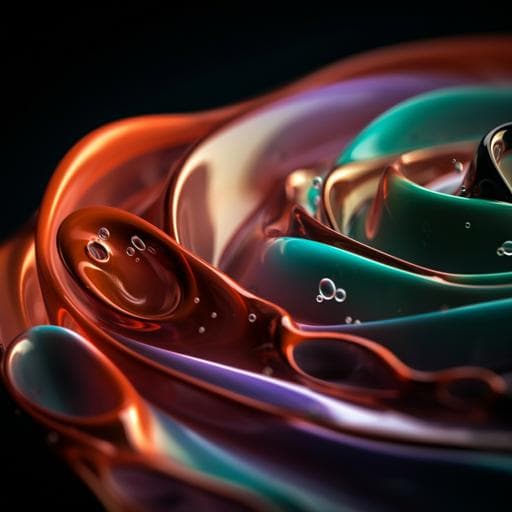
Chemistry
Comparative study of the structure and durability of commercial silicate glasses for food consumption and cosmetic packaging
L. Brunswic, F. Angeli, et al.
This groundbreaking research explores how four different commercial silicate glasses alter under acidic conditions over three years. Through advanced analyses, it was discovered that glass composition significantly affects alteration rates and element depletion. The research was conducted by Léa Brunswic, Frédéric Angeli, Thibault Charpentier, Stéphane Gin, Pierre Asplanato, Huseyin Kaya, and Seong H. Kim.
~3 min • Beginner • English
Introduction
The study addresses concerns about element migration (notably Pb) from household and packaging glasses into foods and beverages, which has driven increasingly strict regulations for food-contact materials. Following reports since the 1990s of lead mobility from lead crystal, there is a need to assess and compare long-term chemical durability of commercial glasses representative of consumer use. The research question is how glass composition and network polymerization affect alteration mechanisms and rates under acidic conditions representative of food contact. The purpose is to compare four commercial silicate glasses (lead crystal, barium crystalline glass, soda-lime, and borosilicate) under identical long-term leaching conditions and correlate structural features with alteration behavior to inform safety and durability in consumer applications.
Literature Review
Prior work identified lead migration from crystalware and led to regulatory thresholds (e.g., EU Council Directive for crystal glass). Soda-lime and borosilicate glass durability under varying pH has been studied, showing ion-exchange and hydrolysis mechanisms. Structural NMR studies have detailed environments in lead crystal, Pyrex-type borosilicates, and aluminosilicate frameworks, linking modifier content to non-bridging oxygen formation and network polymerization. Earlier studies on the same lead crystal composition showed Pb diffusion kinetics and the role of surface silicate repolymerization in passivation. Models for glass corrosion emphasize hydrolysis, interdiffusion, and the formation/role of altered layers, with thermodynamic affinity and rate laws describing Si release. Ab initio work indicates in acidic medium B–O–B and B–O–Si bonds hydrolyze more readily than Si–O–Si in borosilicates.
Methodology
Samples: Four commercial silicate glasses representative of consumer products: A) lead crystal (≥24 wt% PbO), B) barium crystalline glass (sum of ZnO+BaO+PbO+K2O ≥10 wt%), C) soda-lime container glass, and D) borosilicate cookware glass. Slabs (~20×20×2 mm³) were cut and polished (~1 μm finish). Powders (63–125 μm) were prepared, washed, and characterized for specific surface area (BET, krypton gas). Glass compositions were quantified by ICP-AES after complete dissolution (Table values provided in the paper); densities were measured (A: 3.03, B: 2.57, C: 2.52, D: 2.27 g/cm³). Structural NMR of pristine glasses included 29Si, 27Al, 11B, and 23Na MAS and MQMAS to assess network polymerization and speciation (e.g., Qn distribution, BO3/BO4 ratios, Al coordination).
Leaching experiments: Long-term static alteration was performed in perfluoroalkoxy (PFA) reactors at 70±3 °C in 4% (v/v) acetic acid (pH 2.4±0.1). Each reactor contained ~800 mg powder plus one slab; 97% of exposed surface originated from powder. Reactors were sealed and placed in water baths to maintain temperature. The geometric surface-area-to-volume ratio SAgeo/V was used for kinetics (initially ~50 m−1; per glass: SAgeo/V ~43, 57, 56, 39 m−1 for A–D; SABET/V ~102, 104, 101, 101 m−1 for powders). Solutions were periodically sampled (≤10% total volume removed over 3 years) and analyzed by ICP-AES for elemental concentrations. Normalized losses NLgeo,i and equivalent thicknesses EThgeo,i were calculated (Eqs. 2–3); time derivatives provided rates (Eq. 4). Diffusion coefficients for interdiffusing species were derived from rate data (Eq. 5). Cross-batch analytical correction factors were applied (Eqs. 6–7). Solubility of amorphous silica at 70 °C and pH 2.4 was computed with JChess (124 ppm Si), exceeding measured Si (~50 ppm), indicating no silica precipitation.
Solid characterization: SEM-EDX on polished cross-sections of altered powders examined altered layer morphology and elemental distributions. Slabs (after 231 days) were analyzed by ToF-SIMS depth profiling (IONTOF TOF 5, O2+ sputter, Bi analysis; 50×50 μm² area) to determine depth distributions of Na+, K+, Ba+, Ca+, Mg+, Pb+, Si+, Al+, H+, and SiOH+; profiles were normalized to total counts and pristine levels. Altered layer thicknesses were taken from Na depletion and H/SiOH penetration criteria. Spectroscopic ellipsometry (SE) (381–893 nm, 70° incidence) modeled altered layer thickness and open porosity via Bruggeman EMA, assuming the solid fraction optical constants equal to bulk glass. MAS NMR on altered powders (up to 969 days) probed network changes (e.g., 29Si Qn distributions, 1H–29Si cpMAS indicating Si–OH).
Key Findings
- Across all glasses, Si release rates (hydrolysis-controlled) were similar under identical conditions: r(Si) = (9.8±0.5)×10⁻¹² μm day⁻¹ at 70 °C and pH 2.4, largely independent of glass composition and network polymerization degree.
- Sodium leaching proceeded by ion-exchange/interdiffusion for all glasses, with wide variability reflecting network polymerization: after 56 days, r(Na) ranged from (98±20)×10⁻³ μm day⁻¹ (lead crystal A, least polymerized; NBO≈25.7%) to (2±0.6)×10⁻³ μm day⁻¹ (borosilicate D, fully polymerized; NBO≈0).
- At 231 days (ICP-AES ETh, μm): ETH(Na): A 11.90±0.97; B 0.51±0.04; C 0.99±0.05; D 0.44±0.04. ETH(Si): A 0.38±0.02; B 0.33±0.02; C 0.46±0.02; D 0.28±0.02.
- ToF-SIMS altered layer thicknesses at 231 days (μm): by Na depletion/H penetration/SE: A 7.04±0.20 / 7.11±0.20 / 7.34±0.03; B 0.16±0.02 / 0.17±0.02 / 0.29±0.00; C 0.39±0.05 / 0.41±0.06 / 0.37±0.01; D 0.04±0.005 / 0.12±0.002 / 0.33±0.00 (SE for D considered unreliable due to thinness/low contrast). SE-estimated altered layer open porosity (%): A 5.9±0.21; B 6.4±0.11; C 2.2±0.08; D 0.8±0.04.
- Lead crystal (A): Alkali (Na,K) depletion followed Fickian interdiffusion (ETh vs √t). Si release nearly linear (hydrolysis). Pb initially leached then became strongly retained as a passivating altered layer formed; plateau in ETh after ~56 days. ToF-SIMS showed a ~200±10 nm outer layer fully depleted in Pb and alkalis, overlying ~7 μm dealkalinized hydrated glass retaining Pb (Si–O–Pb). 29Si MAS/cpMAS NMR of 969-day altered powder showed increased Q4/Q3 ratio and Si–OH signatures, evidencing network repolymerization. SEM-EDX after 3 years showed an altered layer up to ~15 μm. Reported Pb diffusion coefficients consistent with prior work (e.g., D(Pb)BET ≈ (8.0±1.6)×10⁻¹² m² s⁻¹ at 70 °C; prior 70 °C: (2.0±0.4)×10⁻¹² m² s⁻¹; 22 °C: (3.1±0.6)×10⁻¹⁴ m² s⁻¹).
- Barium glass (B): Low alteration depths and rates; Na is most depleted with maximal altered depth ~1.14±0.09 μm after 3 years (powder kinetics). After ~200 days, rate decreased due to formation of an altered layer acting as a diffusion barrier, though too thin to resolve by SEM after 3 years. ToF-SIMS (231 days) showed ~160 nm Na-depleted layer and a ~40 nm Si/Al-rich subsurface.
- Soda-lime (C): Preferential Na release by ion exchange; after ~300 days, rates decreased as an alteration layer developed. SEM-EDX revealed a ~1 μm Na-depleted layer after 3 years, consistent with ETh(Na)−ETh(Si) ≈ 0.88±0.05 μm at 1096 days. ToF-SIMS (231 days) showed ~390 nm Na depletion and ~18 nm Si/Al-rich surface zone; alkaline earths (Mg,Ca,Ba) retained in the layer.
- Borosilicate (D): Predominantly congruent dissolution; near-stationary regime with similar interdiffusion and hydrolysis rates and minimal residual altered layer. ToF-SIMS showed ~40 nm Na depletion and ~120 nm H penetration at 231 days; no residual altered layer by SEM after 3 years. A thin B-depleted zone was observed, consistent with preferential hydrolysis of B–O–B and B–O–Si in acid.
- Comparative insights: Degree of network polymerization controls alkali mobility; more polymerized networks (D) retain Na better. Despite structural differences, Si hydrolysis rates are similar at fixed pH, T, and SA/V. Barium (in B) confers higher Na retention and long-term durability compared to magnesium (in C) at comparable network formers content. Al remains tetrahedral and largely retained; ToF-SIMS indicates slight Al depletion within the outermost ~15 nm where charge compensation is limited.
- Measurement cross-validation: ToF-SIMS and SE agreed well for A and C; less so for B and D due to thin layers/low optical contrast. SE-derived porosities were low, indicating limited open porosity in altered layers.
Discussion
Findings show that under acidic conditions typical of many food and beverage environments, hydrolysis of the silicate network dictates Si release at a similar rate across diverse commercial glasses, largely independent of composition and network connectivity. In contrast, alkali leaching varies strongly with network polymerization: depolymerized networks (e.g., lead crystal) enable rapid ion exchange and interdiffusion, forming thick dealkalinized layers, whereas fully polymerized networks (borosilicate) limit interdiffusion and dissolve more congruently with minimal residual layers. Lead crystal uniquely undergoes surface repolymerization (silanol condensation) in the alkali-depleted zone, creating a dense passivating layer that effectively retains Pb over long durations, thereby mitigating ongoing Pb release despite initial mobility. Barium-containing glass shows improved Na retention over magnesium-bearing soda-lime glass, suggesting a beneficial role of Ba in strengthening durability at comparable network formers levels. The subtle near-surface Al behavior observed by ToF-SIMS supports the importance of charge compensation in the outermost hydrated zone. Collectively, these results reconcile structural descriptors (Qn distribution, BO3/BO4, charge-compensated Al) with macroscopic leaching kinetics and highlight that controlling network polymerization and modifier roles can tune durability for safe food-contact applications. Cross-technique comparisons (ICP-AES ETh, ToF-SIMS, SE, SEM-EDX, NMR) provide a consistent mechanistic picture while underscoring limitations of optical modeling for ultrathin altered layers.
Conclusion
This comparative, long-duration study links glass structure to alteration mechanisms and durability for four commercial glasses in acidic conditions. Despite compositional diversity, Si hydrolysis proceeds at a common rate for fixed pH, temperature, and SA/V, while alkali mobility scales with network depolymerization. Lead crystal forms a thick dealkalinized, repolymerized passivating layer that retains Pb, whereas borosilicate dissolves nearly congruently with minimal residual alteration. Barium-containing glass exhibits higher Na retention and long-term durability than magnesium-containing soda-lime glass. The multi-technique approach (ICP-AES, ToF-SIMS, SE, SEM-EDX, MAS NMR) provides self-consistent insights spanning nano- to micro-scales. These results support the suitability of glass as a durable, recyclable material for sustainable food and cosmetic packaging and suggest design pathways—enhanced network polymerization, appropriate modifier selection—to optimize safety and durability. Future work could broaden pH/temperature ranges, assess dynamic flow conditions, refine optical modeling of ultrathin layers with composition-dependent refractive indices, and investigate trace element retention mechanisms across broader compositions.
Limitations
- Analytical interferences: Potassium contamination from the pH probe affected K data (B, C) and possibly Na depletion assessment in D; calcium data suffered lab contamination and noise.
- Spectroscopic ellipsometry modeling assumed alteration-layer solid optical constants equal to bulk glass, reducing accuracy for very thin layers (<200 nm) or gradients; SE was less reliable for B and D due to low optical contrast.
- ToF-SIMS provides local measurements (50×50 μm²) and may miss larger-scale heterogeneity; depth calibration assumes constant sputter rate.
- Experimental conditions were fixed at pH 2.4 and 70 °C without stirring; generalization to other pH/temperatures or dynamic conditions requires caution.
- Only four commercial compositions were tested; broader compositional space may reveal additional trends. Thermodynamic effects of rising Si concentration over long durations may slightly influence hydrolysis rates though silica saturation was not reached.
Related Publications
Explore these studies to deepen your understanding of the subject.







